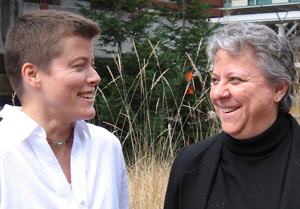Serendip is an independent site partnering with faculty at multiple colleges and universities around the world. Happy exploring!
Week Ten (Mon, 3/28): Paneling A-new: From the "Outside"
![]()
Collage on salvaged wood panel, 2008
Before we begin to "panel anew"....
I. coursekeeping
4 notetakers today: MSA322, kelliott, tiffany, fawei
two more panels on Wednesday
papers due @ midnight on Friday
would any of you like to join us here (or in 300??) tomorrow night @ 7:30,
for a "skyped" broadcast of Abha Sur's presentation (in the MIT
class on Gender and Technology), focusing on the global impact of new reproductive technologies ???
3 new related readings in our password protected file:
Sex-Selective Abortions in India
Thinking Through the Diaspora: Call Centers, India and A New Politics of Hybridity
Crossing Bodies, Crossing Borders: International Surrogacy Between the United States and India
II. (Liz) talking about Barad and Tian....
At the end of her discussion of Barad last Monday,
Liz asked these questions:
* Is she convincing? Has she achieved her new contribution to this physical theory we call Quantum Physics?
* How are her proposals for a new interpretation of the components of quantum theory an example of feminist science studies?
* What would you like to understand better? What questions remain for you?
We heard some good additional questions @ the end of Monday's class:
* Why do we need to know the physics, to understand her argument?
* Is her result only important for particle physicists, and not for the rest of us? What message does her work have for non-scientists?
* How does her work add to the themes of this course so far?
TiffanyE: After class on Monday, I started thinking more about whether objectivity is possible in the physical world. The video we watched on Dr. Quantum and how particles react differently when being observed made me wonder if the behavior of the particles mirror the real world. Perhaps the way in which the world as we know it is actually classified by those who control information, despite what the actual fact of the matter is. When we discussed gender earlier in the course, we talked about how classifications are restricting. Perhaps these classifications, like many other classifications we use, actually mirror the views of those who create the classifications, and are subjective rather than objective.
 |
 |
Let's also take some time to process our conversation w/ Tian.
vgaffney: In discussing her view of quantum entanglement, Barad reviews Einstein and Bohr’s understandings of objectivity. Einstein argued that there must be separability between the observer and the observed in order for there to be objectivity. Bohr, on the other hand, argues that the observer and the observed can be entangled because what matters for objectivity is that the object being measured leaves “unambiguous” and “reproducible” marks for the observer. Barad draws from Bohr’s understanding of objectivity and concludes that the human observer is not separate from the phenomenon he/she observes, but entangled with the object of observation. The human “seeks to understand the emergence of the ‘human’ along with all other physical systems”. Barad’s notion of object/observer entanglement, where the observer is not separate, but a part of the phenomenon which he/she observes came to mind during Professor Tian’s talk when he discussed what music is. What music “is” has been challenged recently, most particularly noted with the famous performance at Woodstock which consisted of (what appeared to be) pure silence and no sound. As David Tutor comments, however, the audience “missed the point, there's no such thing as silence. What they thought was silence, because they didn't know how to listen, was full of accidental sounds." Barad’s notion of entanglement came to mind during the discussion on musical notation, where Professor Tian mentions that on its own, musical notation is not music; the combination of notation and performer (who produces the music) is necessary to create the music. Taking Barad’s terms into account, I view the notation as the object being “measured” and the performer as the “measurer”; the performer and the musical notation come together to create music. The result is a productive “entanglement” of performer and notation where the performer (measurer) recognizes him/herself as an integral part of the process of music itself (measured).
* What other connections do you see between Tian's presentation and the topics we've discussed?
III. (Anne) PANELS:
We've ask each panel member, of this panel of 9,
to prepare a 3-minute mini-presentation ahead of time,
in which you will introduce yourself,
tell us what group you are representing,
why this group is of interest to GIST,
and how the intersections embedded in GIST have affected your group.
We have asked all 18 audience members to review the list of panelists ahead of time, to come ready w/ some more directed questions to explore more deeply the significance of the groups and their inter-actions, intra-actions and experiences with GIST.
Group One (Monday)
tangerines: art students
m.aghazarian: masters of Library and Information Science
Apo: facebook users
Franklin20: youtube community
HillaryG: X-Men
shin10681111: video gamers
leamirella: docs @ Lovelace Women's Hospital in Albuquerque
MissArcher2: women who sought late-term abortions from Philadelphia doctor Kermit Gosnell
aybala: US immigrants


